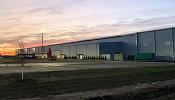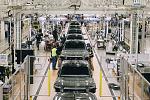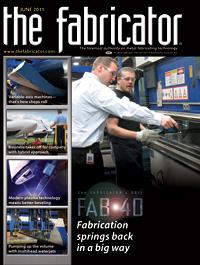Editor-in-Chief
- FMA
- The Fabricator
- FABTECH
- Canadian Metalworking
Categories
- Additive Manufacturing
- Aluminum Welding
- Arc Welding
- Assembly and Joining
- Automation and Robotics
- Bending and Forming
- Consumables
- Cutting and Weld Prep
- Electric Vehicles
- En Español
- Finishing
- Hydroforming
- Laser Cutting
- Laser Welding
- Machining
- Manufacturing Software
- Materials Handling
- Metals/Materials
- Oxyfuel Cutting
- Plasma Cutting
- Power Tools
- Punching and Other Holemaking
- Roll Forming
- Safety
- Sawing
- Shearing
- Shop Management
- Testing and Measuring
- Tube and Pipe Fabrication
- Tube and Pipe Production
- Waterjet Cutting
Industry Directory
Webcasts
Podcasts
FAB 40
Advertise
Subscribe
Account Login
Search
Don't waste a good recession
During the recent slowdown, Seconn Fabrication made investments to prepare for bigger opportunities ahead
- By Dan Davis
- June 7, 2011
- Article
- Shop Management

Figure 1: A recession may not seem like the best time for an expansion, but with the construction industry suffering as well, Seconn Fabrication picked an opportune time to add 25,000 square feet to accommodate future growth.
It was the education that I will never forget." That's Rob Marelli, owner and president of Seconn Fabrication, Waterford, Conn., reflecting on the recession, which officially ended in June 2009, but still lingered for several months in other industrial sectors. Not many people would describe living through those days as a positive experience, but Marelli is certain his company is better off for it.
Even with business heading south in 2009, Seconn pushed ahead with a 25,000-square-foot expansion, a manufacturing resource planning (MRP) software implementation, and a new silk screening operation. On the shop floor, employees learned additional job functions and conducted several kaizen events aimed at weeding out waste in targeted fabricating activities. The company even moved forward with a new business unit.
That's right. Seconn launched a new fabricating business—Solar Fabricators. With some of its best employees. Down the street.
Now, that probably leaves some people scratching their heads, but it's one of the realizations that came to Marelli during the recession. As business forecasts became cloudier in 2009, Marelli saw his own business more clearly. In fact, he grew more confident in Seconn, The FABRICATOR's 2008 Industry Award winner and No. 28 in the 2011 FAB 40.
Marelli shared his thoughts about those unsettling months, the steps Seconn took to survive, and the plans that the company has put together to grow aggressively over the next couple of years.
The FABRICATOR: How did Seconn Fabrication weather the last two years?
Rob Marelli: We weren't immune as far as top line. My revenue got cut in half by the first quarter of '09. We were going from $10.5 million a year and $900,000 a month, and by April 2010, I was at $450,000 a month.
But here's the best part, believe it or not: That year, 2009, we were in the black 11 out of those 12 months. In that free fall we had the tenacity to make whatever tough calls we needed to get through it. I loved it.
The recession was almost the secret to my future success. I'm grateful that happened—to learn those lessons at 43 and not 63.
FAB: What were some of those lessons?
RM: Obviously, the easy ones. Cash is king. The fact that you have to have diversification in your revenue stream. Thank God we were in multiple industries. Of course, all industries were hurting me, except for health care. My largest account at the time was only 9.5 percent of my revenue.
Having the guts to make those tough calls. What got us through was knowing what our threshold of pain was, knowing that, when we went all the way down from $900,000 per month to $450,000, that we made money. It wasn't a lot, don't get me wrong. We weren't afraid to make the pay cuts or salary freezes. We weren't afraid to go down to 30 hours. We did what we had to do.

Figure 2: In addition to fabricating activities, some light assembly work and machining take place in the company’s new work area.
We hired right. We had the right guys, and they had skin in the game. For them not to be afraid and have the can-do spirit was really a difference-maker.
FAB: Did you have layoffs?
RM: We always hired ahead. I used to work for a guy who would wait for a PO, and then he would go find the bodies. So what we do is we work with three temp agencies. They know what we want. They know we have a no-cell-phone policy, and they know we drug-screen.
So in 2008 we were up to 66 people. So we lost some, but some were temps for hire. We went down to about 50. Those people that we lost were not my core guys. It didn't hurt my core competencies. I didn't lose the guys that could run three pieces of equipment.
We are now back in the high 50s, maybe 57 or 58.
We actually made more money in 2009 on $7 million in sales than we did in 2008 at $10.5 million in sales. It was really an eye-opening experience.
We grew so fast to $10.5 million, and we were leaving some of it on the table. When the recession came, we went into it and were challenged by it. We took it as an opportunity. It made my whole organization healthier.
It was a great opportunity for us. We loved it. It was probably my best year managing. And it was probably the year I was proudest of.
FAB: Looking back, what factors helped Seconn out the most during the economic downturn?
RM: Having cash. No doubt about it. Having that community bank that was not afraid to help us. The sky was falling, and everyone knew it. My guy checked with me and asked if we needed anything.
Those guys being cross-trained was huge. No one was giving you blank orders anymore. Everyone was spot buying. The guy that wanted 50, and he had only 23 sold. Guess what? He's only buying 23. Being able to move those bodies around and not being pigeonholed. It was huge for us.
FAB: What sort of projects did Seconn undertake over the last couple of years in the face of the recession?
RM: We added 25,000 square feet [see Figure 1]. We acted as the general contractor. We were in under $1 million when it was all said and done.

Figure 3: In setting up Solar Fabricators down the road from Seconn, Marelli and his team cleaned up the old Crown Manufacturing building and invested in new equipment, lighting, landscaping, and paint. By the beginning of this year, the new fab shop was ready to take on small projects, such as repairing snowplow blades, that don’t fit Seconn’s business model.
We made significant investments in IT. We have a new MRP system. We are now running E2.
One of the things that we were looking forward to when we got through this thing was having more intimacy with our clients. We're talking about a portal on our Web page that was password-protected and had e-mail triggers for job stat-uses. We also went paperless.
We obviously took advantage of the interest rates. With what happened in '09, we just took a lot of 7.5 and 9.5 percent money down to 4 or 5 percent. It was a no-brainer.
We did numerous kaizen events. Being as diversified as we were, trying to put all of the work on the shop floor the same way was difficult. So being able to look at some similarities between the scopes of work and organize schedules accordingly made sense. For example, we have some high-volume stuff and some high-end weldments, so we developed silos, or plants within a plant, to force us to have the right people and the right tools in place not only to increase our productivity and efficiencies, but also to enhance our quality.
We diversified our offerings a little bit. We went into silk screening, which was a huge benefit in terms of controlling our lead-times. We put about $20,000 into the equipment and went after a guy with 20 years of experience. Now we have two or three guys out there.
We went into light assembly [see Figure 2], just some mechanical stuff. A lot of our clients didn't want to hold onto the variable cost of their direct labor. One week they were assembling cabinets that were formed in a press, and the next week their guys were pushing brooms. We took over a lot of their bill of materials and locked up the accounts. So now we assemble for about five or six accounts.
FAB: What was the reasoning behind the creation of Solar Fabricating?
RM: One of the reasons that we went after Solar [see Figure 3] so aggressively was that our audience was changing here. We began looking at the opportunities that were presenting themselves. In the end, we actually created a solution for more of those transactional-type accounts.
As our business has grown, we've added more layers of bureaucracy and set up more quality procedures. In the old days it would be, "Hey Rob, I have a part that you need to look at," and I would send a truck right then. You could pick up the phone and act that quickly. Now you have to go through layers to get the same decisions done, and not everyone wants to pay for that. But some of these larger accounts want to do business that way, and we have begun to gravitate toward that.
I said let's take this thing [a former sheet metal shop] up the street, and we can create this small business. Maybe transactional-type accounts don't fit Seconn today, but they sure fit Seconn four to five years ago. So let's get back to basics and create a business model that is suited for that.
It's worked out quite nicely.

Figure 4: Seconn actively tries to recognize employee contributions. On this particular day, a visit from the ice cream man broke up a typically busy day on the shop floor.
FAB: Are you confident with the decision to set up another metal fabricating shop down the street?
RM: I feel very confident in where we are in the marketplace. I feel very confident that when I finish building the team here at Seconn, I can double my business in less than five years.
In attempting to do that, I had to look at the book of business. What are my options? Increase the organization to make it worth the pain of handling some of these smaller accounts? Give that business to someone else? Ignore it?
So now I've given a couple of my managers—who have grown with me for five or six years, who understood our early days, who understood the walk-in guys, the entrepreneurs, and the small commercial accounts—a chance to succeed. Shift the revenue stream over into the business model that is more suited for it and is able to deliver the attention it deserves. Why ignore it here at Seconn?
So at Solar, the equipment is ready. The fourth quarter of last year was just getting it ready. Over the last four months [as of early May], it has begun to grow from $75,000 per month to $200,000 per month. The benefit here is that my direct labor-to -sales ratio used to be $0.20 on the dollar. It is now $0.15 on the dollar. I've picked up 25 percent more productivity here at Seconn just by getting the noise out of the way.
Now I have 11 guys over there.
FAB: How have customers reacted to the creation of Solar?
RM: We haven't had any push back at all. We did have one account that did remain with Seconn because they needed to be ISO-certified. Solar is not ISO-certified. That was the only one that has had any problem.
The best part is that my guy is on the road and making calls. He has been sitting down in our monthly sales meetings, and he knows where we are going. When he now makes the call, he has a Swiss Army knife. If he shows up at a call now and he finds out there is not much there [in terms of volume], he now has an option. It's not a wasted call.
FAB: What's driving Seconn now that it's made it through the tough times?
RM: Most entrepreneurs are risk-takers and gamblers. With me, you get high with the highs and low with the lows. And I guess a lot of business owners do. You can never shut it off. There are always challenges.
From '03 to '08, the challenges became less and less. Then the economy jolts you. It's time to say, "Let's go. Give me your best shot." Maybe it's fear that drives some of your decisions. You can either face it or run from it.
It got me juiced up all over again. Then to come through it and get to the other side. To know that you just went through what people are calling the worst recession in 70 years. Everybody stuck with you and you didn't lose any key workers [see Figure 4]. You turned a better profit than you did the year before.
Then you start to reflect on what you did wrong in '08. Why did I make more money on $7 million than $10.5 million? Those bad decisions then become glaring. So now, in hindsight, you start changing your marketing strategy, and you get some new opportunities coming your way.
It's time to ask the question: Do you want to be a good $7 million or $8 million company, or do you want to try and be the best in your area and grow your business in the best interest of all of your employees? And I chose the latter. That's what has me cranked up right now. I know that we can be a premier shop in this area.
Seconn Fabrication, 180 Cross Road, Waterford, CT 06385, 860-443-0000.
Solar Fabricators, 147 Cross Road, Waterford, CT 06385, 860-442-4325.
About the Author

Dan Davis
2135 Point Blvd.
Elgin, IL 60123
815-227-8281
Dan Davis is editor-in-chief of The Fabricator, the industry's most widely circulated metal fabricating magazine, and its sister publications, The Tube & Pipe Journal and The Welder. He has been with the publications since April 2002.
subscribe now

The Fabricator is North America's leading magazine for the metal forming and fabricating industry. The magazine delivers the news, technical articles, and case histories that enable fabricators to do their jobs more efficiently. The Fabricator has served the industry since 1970.
start your free subscription- Stay connected from anywhere

Easily access valuable industry resources now with full access to the digital edition of The Fabricator.

Easily access valuable industry resources now with full access to the digital edition of The Welder.

Easily access valuable industry resources now with full access to the digital edition of The Tube and Pipe Journal.
- Podcasting
- Podcast:
- The Fabricator Podcast
- Published:
- 05/07/2024
- Running Time:
- 67:38
Patrick Brunken, VP of Addison Machine Engineering, joins The Fabricator Podcast to talk about the tube and pipe...
- Trending Articles
White House considers China tariff increases on materials

A deep dive into a bleeding-edge automation strategy in metal fabrication

A visit to Automate 2024 reveals the future might be now

Majestic Steel Arkansas fully operational

Rivian to expand Illinois facility to manufacture midsized SUV

- Industry Events
Laser Welding Certificate Course
- May 7 - August 6, 2024
- Farmington Hills, IL
World-Class Roll Forming Workshop
- June 5 - 6, 2024
- Louisville, KY
Advanced Laser Application Workshop
- June 25 - 27, 2024
- Novi, MI
Precision Press Brake Certificate Course
- July 31 - August 1, 2024
- Elgin,


























